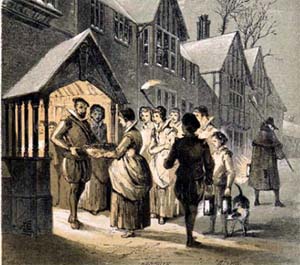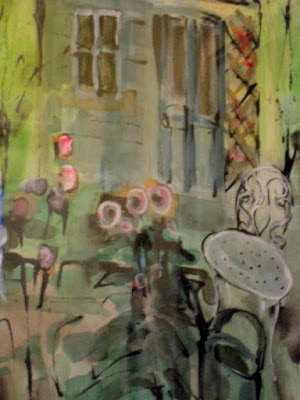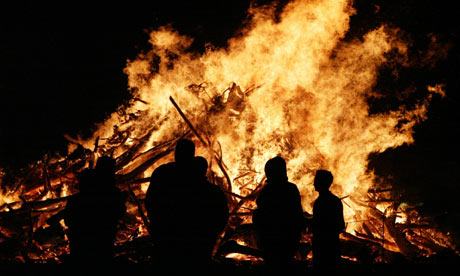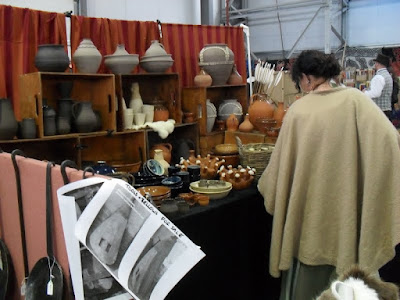Every year at about this time, a group of villagers get together to sing carols around the village - with voices combining to carry through the chilly winter air, the itinerant choir processes along the lanes, stopping outside houses, shuffling sheet music as they switch from one tune to the next. Finally they stop to soothe their song-sore throats at their last port of call: the local pub.
Origins of wassailing/Yulesinging
Some
scholars prefer a pre-
Christian explanation of the old traditional ceremony of wassailing. How far the
tradition dates back is unknown but it has undeniable connections with
Anglo-Saxon pagan ritual. Of recent times the word Wassail (from the
Anglo-Saxon toast
Wæs þu hæl, "be thou hale" — i.e., "be in good health") has come to be synonymous with
Christmas. The word wassail is
old English and so may predate the
Norman conquest in 1066. The correct response to the toast is
Drinc hæl.
There are three forms of Christmas/New Year celebration involving wassail, a beverage originally made of mulled ale, curdled cream, roasted apples, nuts, eggs and spices. In modern times the concoction has been replaced by eggnog or spiced cider, but the legend of its inception goes right back to Saxon times and is spelt out in Geoffrey of Monmouth's
History of the Kings of Britain and involves Rowena, daughter of Hengist, a Saxon mercenary, who presents the future King Vortigern with a bowl of mulled wine. Vortigern, of course, falls in love with the beautiful Saxon maiden and marries her. Traditionally this drink and its more modern variant, Lamb's Wool, is served on New Year's Eve and Twelfth Night. Lambs Wool is heated cider spiced with sugar, nutmeg and ginger. Roast apples float on the surface and when the soft apple pulp bursts into the vat, it gives the drink a frothy or woolly look.
Lisa Agnew - Time Travel Britain
Christmas was not celebrated anywhere before the third century, and only gradually moved northwards through
Europe. It was probably the
Normans who brought the celebration to
England. Traditionally, the wassail is celebrated on
Twelfth Night (mostly regarded as January 6, but more properly the evening of January 5). However most people insist on wassailing on 'Old Twelvey Night' (January 17) as that would have been the correct date before the introduction of the
Gregorian Calendar in 1752.
The practice has its roots in the
middle ages as a reciprocal exchange between the
feudal lords and their
peasants as a form of recipient initiated charitable giving, to be distinguished from
begging. This point is made in the song "
Here We Come A-Wassailing", when the wassailers inform the lord of the house that
- "we are not daily beggars that beg from door to door but we are friendly neighbours whom you have seen before."
The
lord of the manor would give food and drink to the peasants in exchange for their blessing and goodwill, i.e...
- "Love and joy come to you,
- And to you your wassail too;
- And God bless you and send you
- a Happy New Year"
... which would be given in the form of the song being sung. Wassailing is the background practice against which an English carol such as "
We Wish You a Merry Christmas" dating back to sixteenth century England, can be made sense of.
The carol lies in the English tradition where wealthy people of the community gave Christmas treats to the carolers on Christmas Eve such as 'figgy puddings'.
Although wassailing is often described in innocuous and sometimes nostalgic terms, the practice in England has not always been considered so innocent. Wassailing was associated with rowdy bands of young men who would enter the homes of wealthy neighbours and demand free food and drink in a trick-or-treat fashion. If the householder refused, he was usually cursed, and occasionally his house was vandalized. The example of the exchange is seen in their demand for "
figgy pudding" and "good cheer", i.e., the
wassail beverage, without which the wassailers in the song will not leave; "We won't go until we get some, so bring some out here."
Figgy pudding is a pudding resembling something like a white Christmas pudding containing figs. The pudding may be baked, steamed in the oven, boiled or fried. The history of figgy pudding dates back to 16th century England. Its possible ancestors include savory puddings such as crustades, fygeye or figge (a potage of mashed figs thickened with bread), creme boiled (a kind of stirred custard), and sippets. In any case, its methods and ingredients appear in diverse older recipes.
Extract from The Magic Apple Tree by Susan Hill - Winter
Christmas Eve comes. This year it came cold; frost lay hard as iron, the gutters and taps hung
with icicles like sugar sticks and all the rooftops and stone walls, the garden fences and the gravestones, gleamed phosphorescent, like silver snails' trails, where it had rained a little
that morning and then suddenly frozen. Our breaths plumed out on the air, out footsteps rang, the stars prickled. There was that curious crackling feel to the atmosphere as it touches face and fingers. Barley lay, empty and beautiful under the frost-rimmed moon. Behind closed doors and curtained windows, in firelight and lamplight, people waited.
.......
Our fingers were stiff with cold and our voices raw as cheese-graters. The church clock struck ten. Some of the children were taken home. It was colder still, too cold for snow. We were glad to get to the Manor House again, and pile into the hall in the old way, for mince-pies and sausage rolls and punch and the blaze of the fire on our frozen faces. The lights went out, except for those of the tree. Silent Night, which brings tears to the eyes. A second or two of absolute silence, before the bursting of a log up like a firework and down again in a great golden shower of sparks. Laughter and lights again and a Happy Christmas floating faint on the freezing air down all the lanes and home.
.......















































